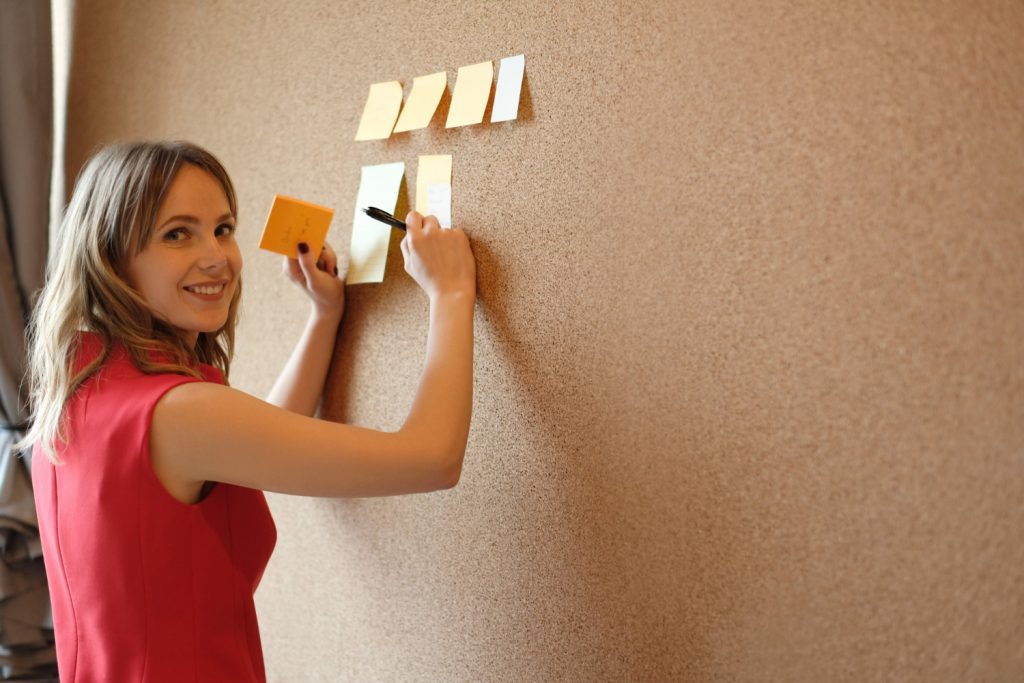A cork board is a tool that can make learning much easier in any field. Learn how to use it to study effectively and have fun.
Cork boards – a valuable learning aid
A cork board is an excellent tool to organise thoughts, ideas, and information, making it a perfect aid for studying. You can easily pin printouts and sticky notes with vocabulary lists to its surface, creating an area that facilitates and improves knowledge acquisition. Cork boards not only help you learn more in less time but also develop creativity as you discover new ways to incorporate them in in your study routine.
Practical applications:
- A space for notes: display task lists, definitions, or questions you are working on.
- Mind mapping: pin sticky notes with key concepts to create mind maps that can help you understand even the most complex topics.
- Creating diagrams: use the board to create diagrams by pinning individual notes containing specific elements to explain complex concepts.
Using cork boards for study planning
Cork boards are especially helpful in creating detailed study plans that allow you to track your progress. Pin colourful sticky notes with tasks to complete or questions to revise. Another great idea is to give thematic groups specific colours to make them easily distinguishable. Sticky notes are also great for marking priority tasks – just stick them to documents pinned to the board. Highlighters on the other hand are great for emphasising key information on printed materials displayed on the board. A well-organised study plan will help you systematically achieve your learning goals.
Note-taking and summarising methods using a cork board
There are several methods involving the use of a cork board that can enhance the effectiveness of learning. Experimenting with different approaches to note-taking and summarising can help you find what works best for you:
- Graphic summaries: pin various cards or notes to the board. Include definitions, formulas, or drawings that you want to keep in sight. This method is particularly good for visual learners.
- Using symbols and colours: coloured pins can categorise information effectively. Assign one colour to definitions and another to formulas, making it easier to find information. Symbols like stars, hearts, or arrows can highlight key points.
- Time management: pin calendar sheets with highlighted exam dates or weekly task lists.
- Visual reminders: attach photos or illustrations related to your field of study to train your memory. Diagrams and charts can also help understand complex concepts.
- Lesson notes: after each lesson, pin the most important information to the board and revise it regularly.
Practical tips for using cork boards as a learning aid
- Regular updates: keep your board up to date to ensure its content aligns with your current needs.
- Use various materials: use different materials, such as sticky notes and colour markers, to highlight content and make it easier to remember important details.
- Personalise: tailor your methods to your preferences and make learning fun.
Boost your memory and creativity
Use these creative techniques to enhance your learning experience:
- Learning through associations: use the cork board to build associations, creating a pyramid of related ideas. Pin sticky notes with words related to the topic you want to remember. This method is brilliant for both memory retention and imagination.
- Using pictures: pin relevant images to help you understand and retain new concepts faster.
- Creative diagrams: combine sticky notes with images to create personalised visual aids, making learning more engaging.
Motivational goal and reward boards
Cork boards can also help boost motivation and productivity. Display goals and rewards to keep you inspired and motivated:
- Set your goals: pin a list of short-term and long-term objectives.
- Track progress: use colourful sticky notes to mark completed tasks, allowing you to monitor your achievements.
- Reward yourself: pin symbols or pictures of rewards, such as a walk in the park or a cup of your favourite tea, to celebrate reaching your goals.
Practical applications of cork boards in learning and teaching
Cork boards, used as educational tools, can significantly contribute to the learning as well as teaching process:
- Math students
- Method: pin sticky notes with key mathematical formulas.
- Effect: visual materials make it easier to recall formulas before tests and exams.
- Exam preparation
- Method: create a study timetable on the cork board.
- Effect: An organised plan reduces stress and chaos, improving material retention.
- History teachers
- Method: display historical maps, photos of significant figures, and important dates on the board.
- Effect: lessons become more dynamic, helping students visually trace historical events and understand the topic better.
- Foreign language learners
- Method: pin vocabulary lists and phrases in the target language.
- Effect: regular exposure aids vocabulary retention and communication skills.
In each case, a cork board is more than just a tool—it is a source of inspiration, organisation, and motivation, significantly improving the learning process.
Conclusion
Cork boards are a versatile tool that can support organisation, stimulate creativity, and improve the learning process. They are ideal for displaying mind maps and other elements that spark the imagination. Use them to showcase notes and give you motivation to learn, transforming the cork board into an indispensable aid in achieving your goals.


